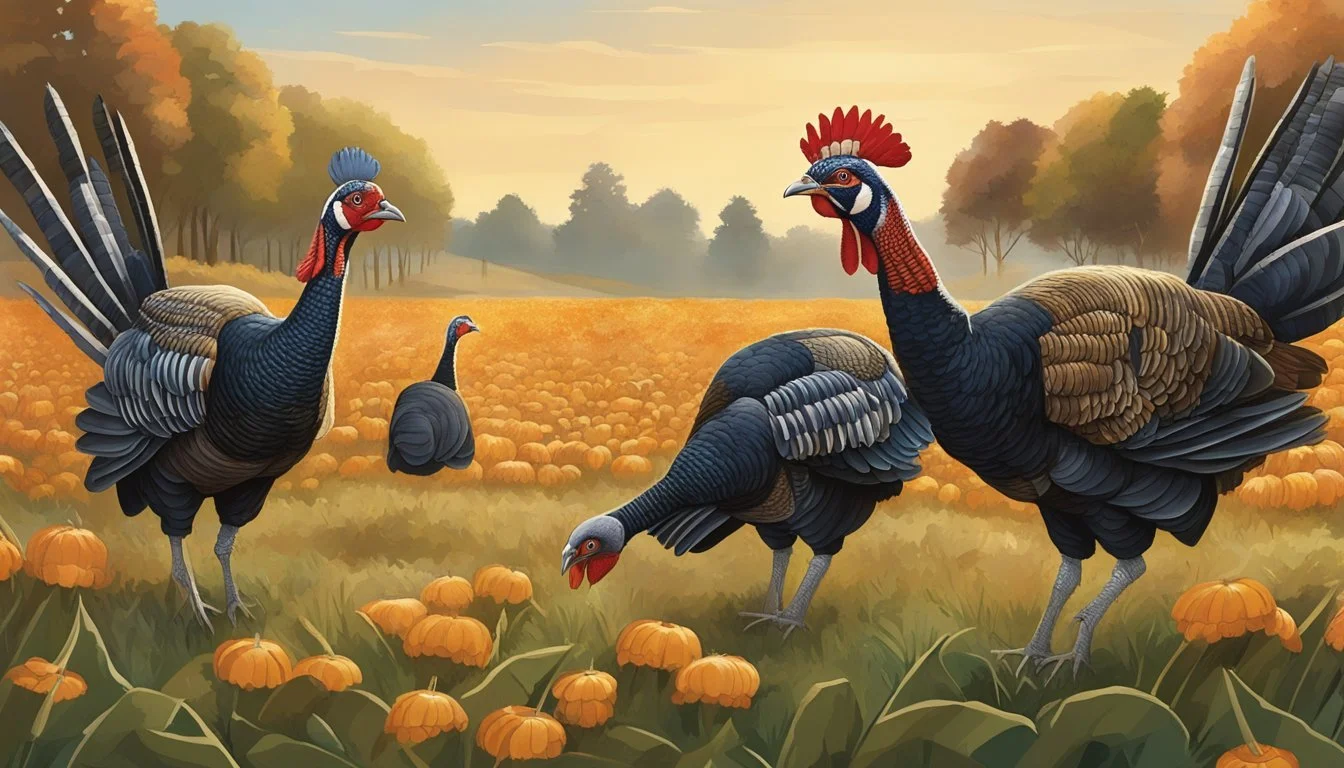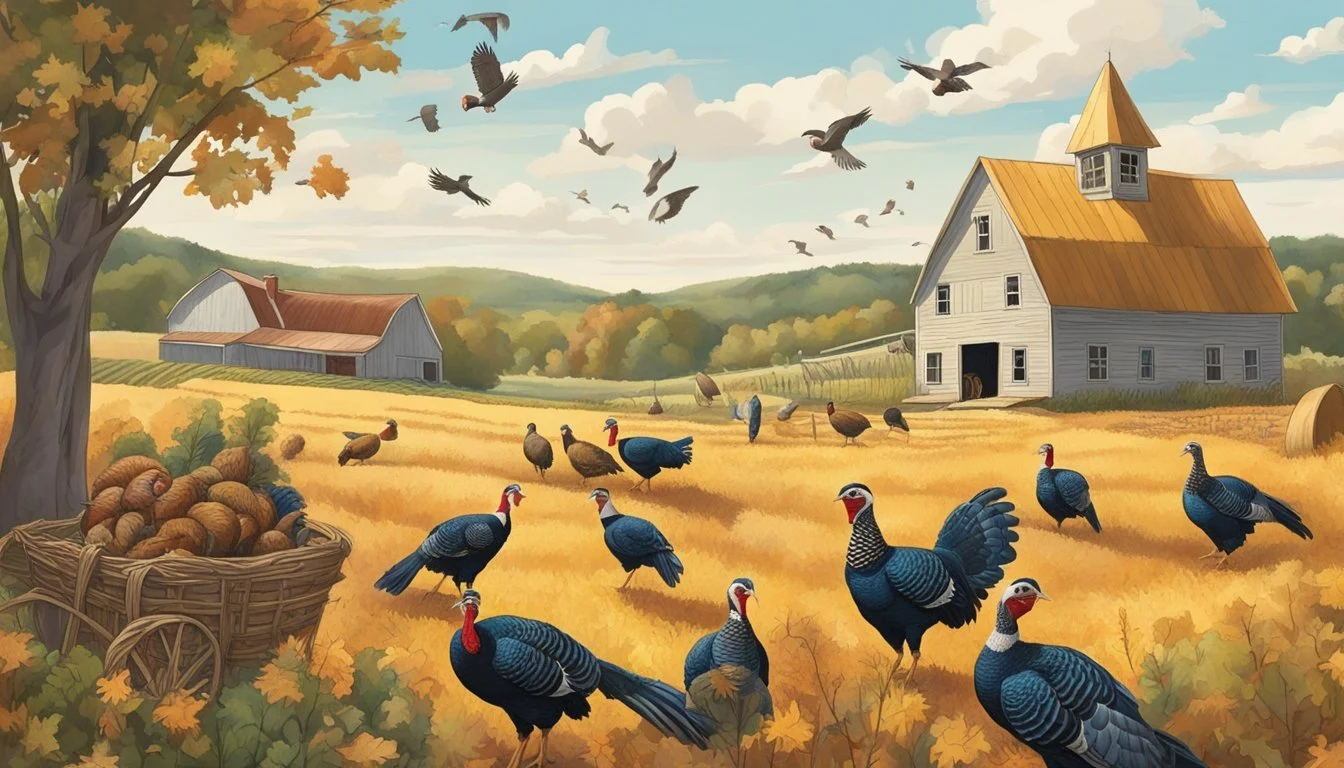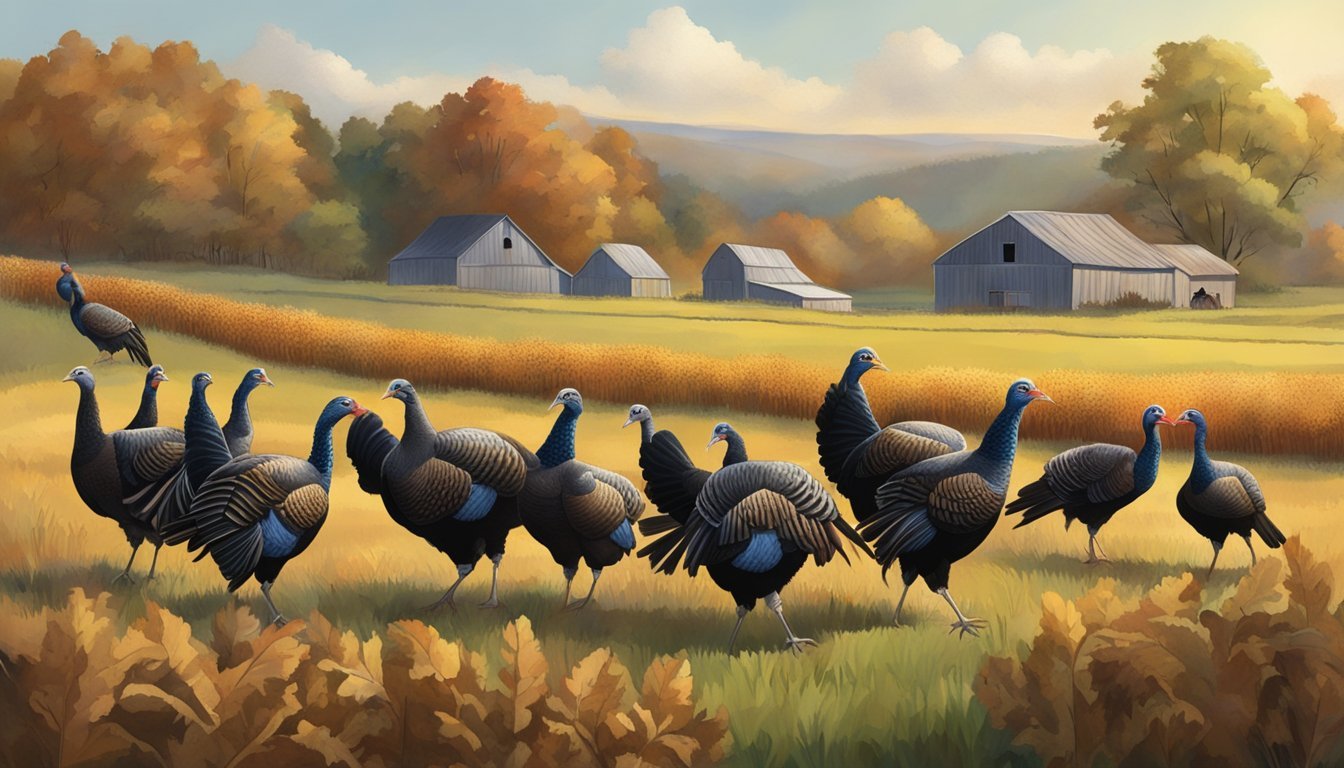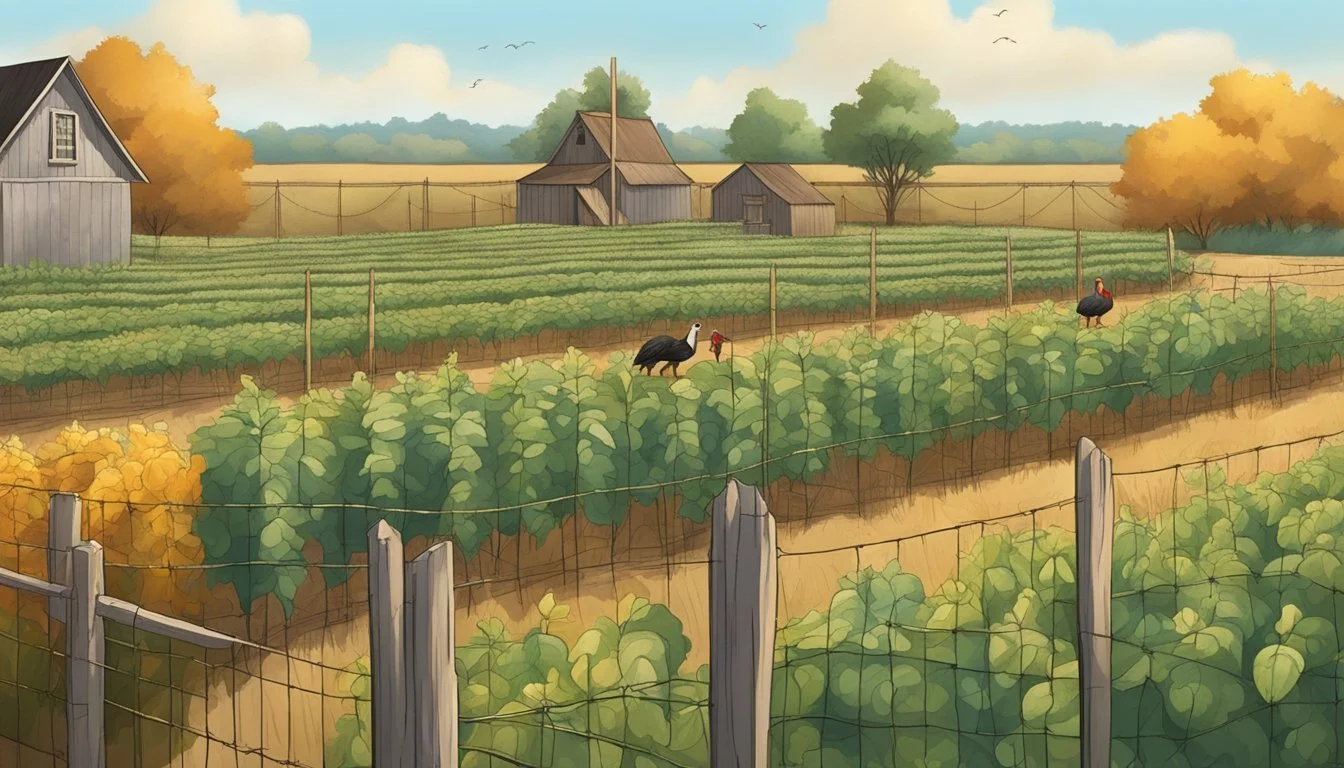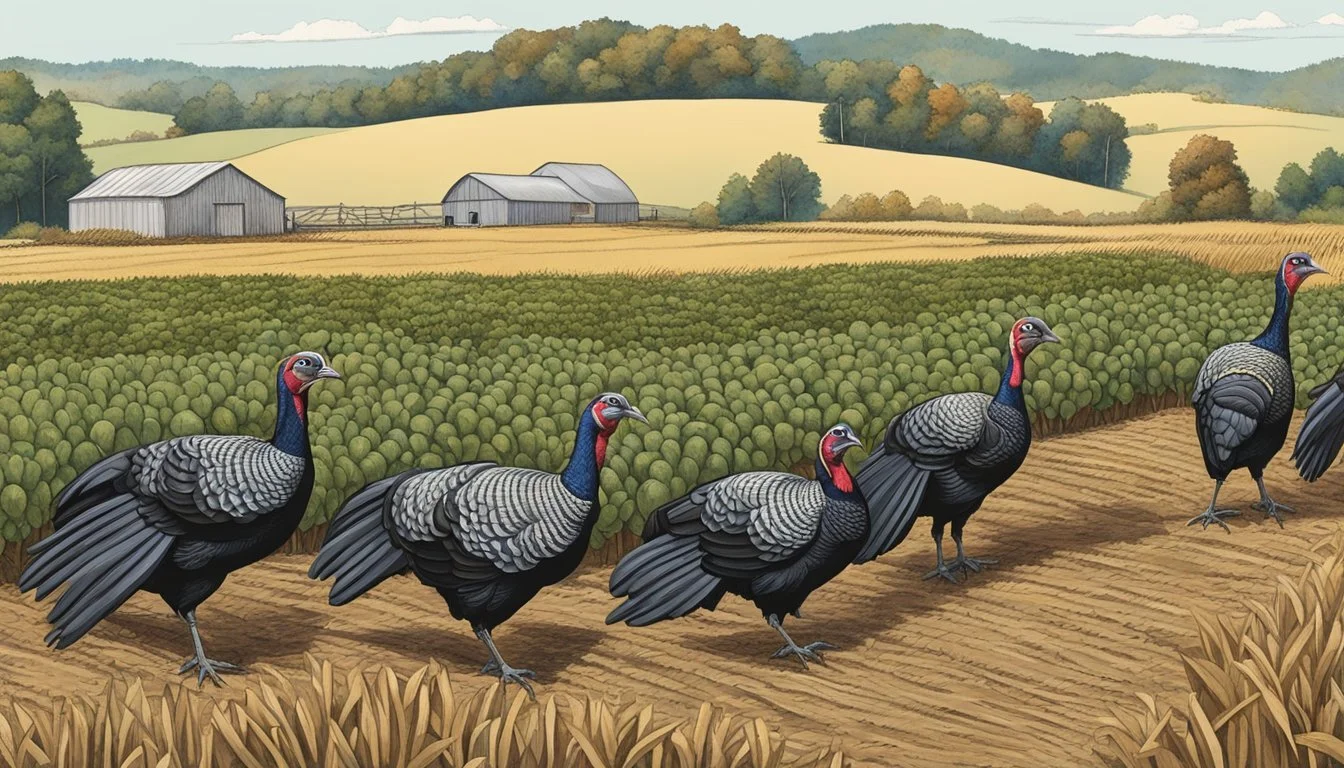Protecting Crops from Eastern Wild Turkey
Effective Strategies for Farmers
The Eastern wild turkey, (What wine goes well with turkey?) a prominent species in North America, has demonstrated remarkable recovery since conservation efforts began in the 20th century. While their resurgence is viewed as a conservation success story, it has also brought increased interactions between these birds and human agricultural practices. Wild turkeys, known for their adaptable feeding habits, pose a challenge to farmers as they can cause significant damage to crops and stored agricultural products.
Managing the impact of wild turkeys on crops requires an understanding of their behavior and habitat requirements. These birds typically forage on the ground, feeding on a diverse diet that includes green foliage, seeds, and insects. The habitat of the Eastern wild turkey spans across various regions, with preferences for open forests and fields that provide both food and shelter. Agriculturists must navigate the delicate balance of protecting their crops while avoiding harm to the wild turkey population and respecting its habitat.
Effective strategies encompass habitat modification and deterrent measures to mitigate crop damage. Initiating habitat enhancements away from cultivated areas can attract wild turkeys to alternative feeding sites, reducing their presence in agricultural plots. Simultaneously, employing non-lethal deterrents can prevent turkeys from encroaching on farmlands without disrupting the overall ecosystem. Through informed wildlife management practices, the interplay between agriculture and the thriving Eastern wild turkey populations can be harmoniously maintained.
Understanding Eastern Wild Turkey Biology
The biology of the Eastern wild turkey reveals an intricate balance between their physical traits, behaviors, and ecological roles, contributing to their survival and the management of their populations.
Physical Characteristics
Eastern wild turkeys display sexual dimorphism; the males (toms or gobblers) are notably larger, often weighing between 16 to 24 pounds, and boasting a fan-shaped tail and a beard—a tuft of coarse bristles protruding from the chest. Females (hens) are smaller, tipping the scales at around 8 to 12 pounds, and lack the distinctive beard.
Diet and Feeding Habits
Wild turkeys are omnivorous, with a diet that varies seasonally. They consume a mix of seeds, insects, and grass during the growing season, shifting to nuts and acorns in fall and winter. In particular, they help control insect populations, such as spiders and forbs.
Reproductive Behavior
The breeding season begins in early spring. Toms strut and vocalize to attract hens, while hens prepare a nest on the ground, typically laying 10 to 14 eggs. After incubation, poults hatch and are guided by the hen as a brood.
Roosting and Movement Patterns
At night, turkeys roost in trees to stay safe from predators. They have a home range that varies but can be several hundred acres. These birds tend to be more sedentary outside the spring hunting season.
Seasonal Behavior
In spring, turkeys are more visible as they engage in breeding activities. During fall and winter, turkeys flock together, and their feeding habits change to adapt to the available food resources.
Wild Turkey Populations
Conservation efforts and wildlife management practices have helped recover turkey populations from the brink of extinction in the 1930s. Population densities and distributions are now closely monitored, often informing management strategies.
Predation Risks
Turkeys face threats from various predators such as raccoons, snakes, and coyotes, especially during the nesting period when eggs and poults are most vulnerable.
Age and Growth
Wild turkeys have an average lifespan of 3 to 4 years. They reach maturity at about 7 months, but toms may not breed until they establish dominance within their flock.
Molt and Feathers
Turkeys undergo an annual molt, replacing their feathers. Males (gobblers) exhibit more impressive plumage as a display during the mating season with iridescent tail feathers.
Distinct Vocalizations
Communication among turkeys is complex and includes a variety of sounds; the gobbler's gobble can be heard up to a mile away. These calls are crucial for maintaining social structure and warning of potential dangers.
Flight Capabilities
Despite their size, wild turkeys are capable of flight, especially when escaping predators or roosting. Their flights are typically short and fast, utilizing their powerful leg muscles.
Social Structure
Wild turkeys maintain a pecking order within their flocks, with dominant toms and hens asserting their status through various displays and interactions. This hierarchy is central to the social interactions and mating behaviors of the species.
Eastern Wild Turkey’s Natural Habitat
Eastern Wild Turkeys require specific habitats that support their complex life cycle, with dense woods and scattered fields providing essential elements such as cover, food, and water.
Habitat Preferences
Eastern Wild Turkeys show a strong preference for a mosaic of hardwood forests and open fields. These environments offer a balance of food, foraging opportunities, and cover. Mature woods, typically with a mixture of oak and hickory trees, provide ample mast such as acorns and nuts. Fields and clearings, often interspersed with grasses and shrubs, supply seeds and insects for protein.
Impact of Weather and Climate
Turkeys are resilient but their habitat use may change with varying weather and climate conditions. They seek thick tree cover or heavy shrubs as a shield against rain and wind. Conversely, they might utilize open areas for foraging after a rain, when earthworms and insects are abundant.
Habitat Restoration Efforts
Organizations like the National Wild Turkey Federation spearhead efforts in habitat restoration. This typically involves planting native trees and grasses, creating open fields, and managing forests to become more suitable for turkey populations.
Foraging Regions
Eastern Wild Turkeys forage across diverse regions, including fields, woods, and areas with pines. They feed on a wide variety of foods, with a diet comprising green foliage, seeds, and insects. Fall and winter months see an increase in foraging for mast like acorns.
Importance of Natural Cover
Natural cover is crucial for Eastern Wildcats both for escape from predators and for resting during the day. Dense shrub thickets, grass patches, and wooded edges provide these turkeys with the seclusion they need.
Roosting Sites
Roosting sites are typically found in large mature trees, where turkeys settle for the night. These elevated sites offer protection from ground predators and provide a vantage point. The characteristics of suitable trees include sturdy branches and a canopy that affords cover.
Human-Wild Turkey Interactions
Encounters between humans and Eastern wild turkeys can lead to a range of outcomes impacting agriculture, ecosystems, and regulations. These interactions span from crop damage to ecosystem benefits and are also shaped by hunting laws.
Agricultural Crop Damage
Eastern wild turkeys are known to cause damage to agricultural crops, seeking out seeds, grains, and plants. Landowners bear the brunt of this, particularly when turkeys forage for waste corn and other leftovers in harvested fields. The damage can be substantial, affecting a landowner's economic bottom line.
Benefits to Ecosystems
Despite these challenges, wild turkeys provide benefits to ecosystems. By consuming insects, they help control potential pests on crops, contributing to the balance of agricultural ecosystems. Their foraging also aids in seed dispersal, supporting plant diversity and forest regeneration, which are key components of wildlife conservation.
Turkey Hunting Regulations
Turkey hunting is regulated to manage the species' population and to mitigate crop depredation. The Fish and Wildlife Service oversees hunting laws, including the spring hunting season, ensuring sustainable harvest limits. These regulations are crucial, as they balance the needs of wildlife species, conservation efforts, and the interests of hunters and landowners.
Wild Turkey Management and Conservation
Eastern wild turkeys require comprehensive management strategies to balance their conservation with the protection of crops. This section delves into the practices and roles pivotal in managing these native birds and their habitats.
Effective Management Practices
Effective management of Eastern wild turkeys encompasses a range of practices aimed at upholding their population while mitigating crop damage. The National Wild Turkey Federation (NWTF) has been instrumental in advancing prescribed burning, forest thinning, and selective grazing methods. These practices contribute to a flourishing habitat for turkeys, promoting healthy ecosystems and diverse food sources, which can reduce the likelihood of turkeys feeding on adjacent crops.
Role of National and Local Agencies
Agencies such as the U.S. Fish and Wildlife Service (USFWS) and state-based Departments of Natural Resources play a crucial role in the conservation and management of wildlife populations. They allocate resources and define management strategies that include controlling predation, overseeing hunting seasons, and implementing sustainable practices alongside local land managers.
Impact of Land Management
Land managers are responsible for executing habitat enhancement activities like prescribed burning and forest thinning. These practices not only bolster turkey habitats but also regulate underbrush growth, which may decrease the likelihood of turkeys invading crop fields. Furthermore, areas managed with biodiversity in mind can support a balanced ecosystem that naturally contains wild turkey populations.
Research and Monitoring
Ongoing research and monitoring are the backbones of effective turkey management. Data gathered from tracking studies, gobbling call surveys like those conducted in Wisconsin, and occupancy models inform conservation strategies. This evidence-based approach, supported by organizations like the NWTF, ensures that Eastern wild turkey populations are sustainable and that management practices adapt in response to ecological changes.
Preventive Measures and Control
Implementing effective strategies for crop protection against Eastern wild turkeys involves a combination of preventative methods and controlling measures. These approaches are tailored to maintain crop integrity while coexisting with wildlife.
Fencing and Barriers
Fencing is a primary defense against turkeys. A sturdy fence should be at least 4 feet high with small mesh sizes to prevent turkeys from slipping through. For added deterrence, electric fencing can be a reliable option. It's also crucial to maintain these barriers regularly to ensure no breaches occur.
Repellent Techniques
Using chemical repellents can be an effective method to discourage turkeys from entering crop fields. Such repellents are developed to be non-harmful to plants but create a repulsive taste or odor for turkeys. It's important to follow application guidelines strictly to maintain efficacy and safety.
Habitat Modification
Habitat modification strategies aim to make the environment less appealing to turkeys. This can include clearing understory vegetation around crop fields to reduce cover and eliminating roosting sites. This method deters turkeys from foraging in the area as they prefer habitats that offer cover and perching opportunities.
Alternative Food Sources
Providing alternative food resources away from crop fields can be an effective way to divert turkeys. Planting a buffer zone with preferred turkey food plants such as wild berries or native grasses can attract turkeys to feed in non-crop areas, reducing the impact on valuable agricultural resources.
Case Studies
The following case studies provide insights into the challenges and successes of managing Eastern wild turkey populations. These efforts range from reintroductions and habitat restoration to conflict resolution and sustainable conservation practices.
Successful Reintroductions
New England has seen an impressive restoration of the wild turkey population. Initial introductive efforts in the 20th century were enhanced by substantial research on turkey habitat preferences, leading to a successful colonization of restored areas. Notably, the return of the wild turkey in Connecticut reflects a strategic approach to species reintroduction.
Population Management Examples
In Texas, the Rio Grande region has demonstrated effective population management, specifically in the Post Oak Savannah ecoregion. Wildlife managers have monitored population densities and implemented hunting regulations to balance turkey numbers with the carrying capacity of the habitat.
Restoration Successes
The National Wild Turkey Federation (NWTF) has been pivotal in wild turkey restoration success across multiple states. Through collaboration with landowners, NWTF has facilitated habitat improvements, ensuring the wild turkey's role in ecosystem balance and biodiversity.
Human-Wildlife Conflict Resolution
Wildlife managers have developed strategies for conflict resolution to protect agricultural crops from wild turkey depredation. These strategies have emphasized coexistence, combining preventive measures like fencing with public education on the long-term benefits of turkeys in agroecosystems.
Long-Term Conservation Efforts
Sustainability in conservation ensures that wild turkey populations thrive without disrupting human activities. Landowners and conservationists have worked together to develop long-term management plans, which include habitat preservation and regulated hunting to maintain turkey populations at healthy levels.
Frequently Asked Questions
When addressing the challenges posed by Eastern wild turkeys to crop production, farmers must employ strategic tactics to both deter and manage these large, native game birds, ensuring that crop yields are protected without causing harm to the turkey populations.
How can farmers deter Eastern wild turkeys from their fields?
Farmers can deter Eastern wild turkeys by using methods such as scarecrows, reflective tape, and noise-making devices which create a perceived threat to the birds avoiding their intrusion into farm fields.
What methods are effective for safeguarding crops against wild turkey damage?
Effectively safeguarding crops involves the use of exclusion techniques like fencing, particularly mesh wire or electric fences, which prevent turkeys from entering crop areas and causing damage.
Which wildlife management practices can protect crop fields from Eastern wild turkey foraging?
Integrated wildlife damage management practices, including the establishment of alternative food plots to distract turkeys from crops and habitat management that encourages turkeys to forage away from agricultural zones, can be highly effective.
Can the presence of wild turkeys affect crop yields, and how can farmers respond?
The presence of wild turkeys can significantly affect crop yields by foraging on plants and compacting soil. Farmers can respond by applying timely harassment techniques or by changing planting cycles to minimize overlap with peak turkey activity periods.
What are the best practices for preventing wild turkey nesting in crop areas?
To prevent wild turkey nesting in crop areas, maintaining regular human activity in the fields can discourage birds from settling, and prompt removal of any brush or debris that could serve as cover for nesting can be beneficial.
Is there any non-lethal approach to manage turkey populations in agricultural settings?
Yes, non-lethal approaches include the installation of habitat modifications and repellents, along with controlled hunting, when in season, to manage turkey populations without causing harm to the birds.


